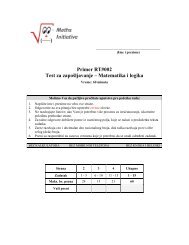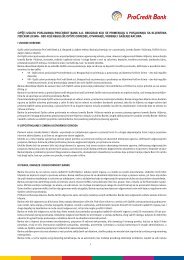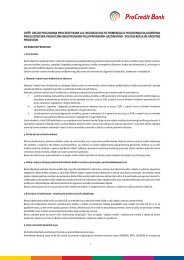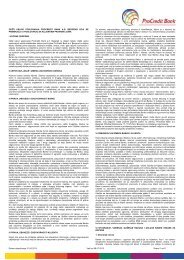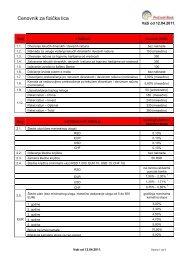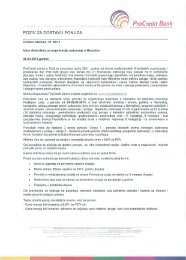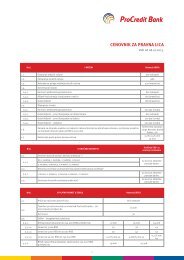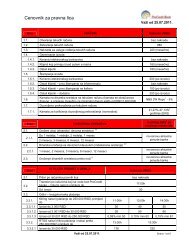Annual Report 2010 - ProCredit Bank
Annual Report 2010 - ProCredit Bank
Annual Report 2010 - ProCredit Bank
- No tags were found...
You also want an ePaper? Increase the reach of your titles
YUMPU automatically turns print PDFs into web optimized ePapers that Google loves.
Financial Statements 51<br />
Group Cash-settled Share-based Payment Transactions - Amendments<br />
to IFRS 2, Share-based Payment (effective for annual periods<br />
beginning on or after 1 January <strong>2010</strong>). The amendments provide a<br />
clear basis to determine the classification of share-based payment<br />
awards in both consolidated and separate financial statements. The<br />
amendments incorporate into the standard the guidance in IFRIC 8<br />
and IFRIC 11, which are withdrawn. The amendments expand on the<br />
guidance given in IFRIC 11 to address plans that were previously not<br />
considered in the interpretation. The amendments also clarify the<br />
defined terms in the Appendix to the standard. The amendments did<br />
not have a material impact on these financial statements.<br />
Eligible Hedged Items—Amendment to IAS 39, Financial Instruments:<br />
Recognition and Measurement (effective with retrospective<br />
application for annual periods beginning on or after 1 July 2009).<br />
The amendment clarifies how the principles that determine whether<br />
a hedged risk or portion of cash flows is eligible for designation<br />
should be applied in particular situations. The amendment did not<br />
have a material impact on these financial statements.<br />
IFRS 1, First-time Adoption of International Financial <strong>Report</strong>ing<br />
Standards (following an amendment in December 2008, effective<br />
for the first IFRS financial statements for a period beginning on or<br />
after 1 July 2009). The revised IFRS 1 retains the substance of its<br />
previous version but within a changed structure in order to make it<br />
easier for the reader to understand and to better accommodate future<br />
changes. The revised standard did not have a material impact<br />
on these financial statements.<br />
Additional Exemptions for First-time Adopters - Amendments to<br />
IFRS 1, First-time Adoption of IFRS (effective for annual periods<br />
beginning on or after 1 January <strong>2010</strong>). The amendments exempt<br />
entities using the full cost method from retrospective application<br />
of IFRSs for oil and gas assets and also exempt entities with<br />
existing leasing contracts from reassessing the classification of<br />
those contracts in accordance with IFRIC 4, ‘Determining Whether<br />
an Arrangement Contains a Lease’ when the application of their<br />
national accounting requirements produced the same result. The<br />
amendments did not have a material impact on these financial<br />
statements.<br />
Improvements to International Financial <strong>Report</strong>ing Standards (issued<br />
in April 2009; amendments to IFRS 2, IAS 38, IFRIC 9 and<br />
IFRIC 16 are effective for annual periods beginning on or after<br />
1 July 2009; amendments to IFRS 5, IFRS 8, IAS 1, IAS 7, IAS 17,<br />
IAS 36 and IAS 39 are effective for annual periods beginning on<br />
or after 1 January <strong>2010</strong>). The improvements consist of a mixture of<br />
substantive changes and clarifications in the following standards<br />
and interpretations: clarification that contributions of businesses<br />
in common control transactions and formation of joint ventures are<br />
not within the scope of IFRS 2; clarification of disclosure requirements<br />
set by IFRS 5 and other standards for non-current assets (or<br />
disposal groups) classified as held for sale or discontinued operations;<br />
requiring to report a measure of total assets and liabilities<br />
for each reportable segment under IFRS 8 only if such amounts are<br />
regularly provided to the chief operating decision maker; amending<br />
IAS 1 to allow classification of certain liabilities settled by entity’s<br />
own equity instruments as non-current; changing IAS 7 such<br />
that only expenditures that result in a recognised asset are eligible<br />
for classification as investing activities; allowing classification of<br />
certain long-term land leases as finance leases under IAS 17 even<br />
without transfer of ownership of the land at the end of the lease;<br />
providing additional guidance in IAS 18 for determining whether an<br />
entity acts as a principal or an agent; clarification in IAS 36 that a<br />
cash generating unit shall not be larger than an operating segment<br />
before aggregation; supplementing IAS 38 regarding measurement<br />
of fair value of intangible assets acquired in a business combination;<br />
amending IAS 39 (i) to include in its scope option contracts<br />
that could result in business combinations, (ii) to clarify the period<br />
of reclassifying gains or losses on cash flow hedging instruments<br />
from equity to profit or loss for the year and (iii) to state that a prepayment<br />
option is closely related to the host contract if upon exercise<br />
the borrower reimburses economic loss of the lender; amending<br />
IFRIC 9 to state that embedded derivatives in contracts acquired<br />
in common control transactions and formation of joint ventures are<br />
not within its scope; and removing the restriction in IFRIC 16 that<br />
hedging instruments may not be held by the foreign operation that<br />
itself is being hedged. In addition, the amendments clarifying classification<br />
as held for sale under IFRS 5 in case of a loss of control<br />
over a subsidiary published as part of the <strong>Annual</strong> Improvements to<br />
International Financial <strong>Report</strong>ing Standards, which were issued in<br />
May 2008, are effective for annual periods beginning on or after 1<br />
July 2009. The amendments did not have a material impact on these<br />
financial statements.<br />
Unless otherwise stated above, the amendments and interpretations<br />
did not have any significant effect on the Group’s consolidated<br />
financial statements.<br />
B) Consolidation<br />
(a) Subsidiaries<br />
Subsidiaries are all entities over which the Group has the power to<br />
govern the financial and operating policies generally accompanying<br />
a shareholding of more than one half of the voting rights.<br />
The <strong>Bank</strong> has only one 100% owned subsidiary – <strong>ProCredit</strong> Leasing<br />
d.o.o.<br />
Inter-company transactions, balances and unrealized gains on<br />
transactions between group companies are eliminated. Unrealized<br />
losses are also eliminated unless the transaction provides evidence<br />
of impairment of the asset transferred. The accounting policies<br />
of subsidiaries have been changed where necessary to ensure<br />
consistency with the policies adopted by the Group.<br />
C) Foreign currency translation<br />
(a) Functional and presentation currency<br />
Items included in the financial statements of each of the Group’s<br />
entities are measured using the currency of the primary economic<br />
environment in which the entity operates (‘the functional currency’).<br />
The consolidated financial statements are presented in<br />
Serbian Dinars (RSD), which is the functional and presentation currency<br />
of the Group entities.<br />
(b) Transactions and balances<br />
Foreign currency transactions are translated into the functional<br />
currency using the exchange rates prevailing at the dates of the<br />
transactions. Foreign exchange gains and losses resulting from the<br />
settlement of such transactions and from the translation at yearend<br />
exchange rates of monetary assets and liabilities denominated<br />
in foreign currencies are recognized in the income statement.<br />
D) Financial assets<br />
The Group classifies its financial assets in the following categories:<br />
loans and receivables and available-for-sale financial assets. Management<br />
determines the classification of its investments at initial<br />
recognition.



